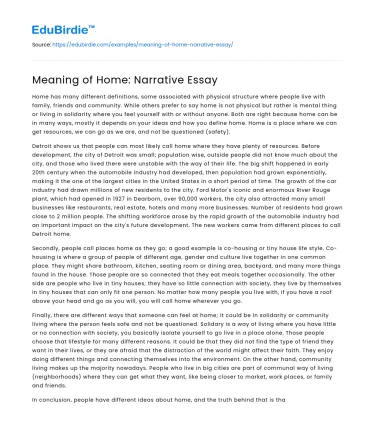Home has many different definitions, some associated with physical structure where people live with family, friends and community. While others prefer to say home is not physical but rather is mental thing or living in solidarity where you feel yourself with or without anyone. Both are right because home can be in many ways, mostly it depends on your ideas and how you define home. Home is a place where we can get resources, we can go as we are, and not be questioned (safety).
Detroit shows us that people can most likely call home where they have plenty of resources. Before development, the city of Detroit was small; population wise, outside people did not know much about the city, and those who lived there were unstable with the way of their life. The big shift happened in early 20th century when the automobile industry had developed, then population had grown exponentially, making it the one of the largest cities in the United States in a short period of time. The growth of the car industry had drawn millions of new residents to the city. Ford Motor's iconic and enormous River Rouge plant, which had opened in 1927 in Dearborn, over 90,000 workers, the city also attracted many small businesses like restaurants, real estate, hotels and many more businesses. Number of residents had grown close to 2 million people. The shifting workforce arose by the rapid growth of the automobile industry had an important impact on the city's future development. The new workers came from different places to call Detroit home.
Save your time!
We can take care of your essay
- Proper editing and formatting
- Free revision, title page, and bibliography
- Flexible prices and money-back guarantee
Secondly, people call places home as they go; a good example is co-housing or tiny house life style. Co-housing is where a group of people of different age, gender and culture live together in one common place. They might share bathroom, kitchen, seating room or dining area, backyard, and many more things found in the house. Those people are so connected that they eat meals together occasionally. The other side are people who live in tiny houses; they have so little connection with society, they live by themselves in tiny houses that can only fit one person. No matter how many people you live with, if you have a roof above your head and go as you will, you will call home wherever you go.
Finally, there are different ways that someone can feel at home; it could be in solidarity or community living where the person feels safe and not be questioned. Solidary is a way of living where you have little or no connection with society, you basically isolate yourself to go live in a place alone. Those people choose that lifestyle for many different reasons. It could be that they did not find the type of friend they want in their lives, or they are afraid that the distraction of the world might affect their faith. They enjoy doing different things and connecting themselves into the environment. On the other hand, community living makes up the majority nowadays. People who live in big cities are part of communal way of living (neighborhoods) where they can get what they want, like being closer to market, work places, or family and friends.
In conclusion, people have different ideas about home, and the truth behind that is that they call a place home where they find themselves most combatable, have sense of belonging, and have no worry about judgment.






 Stuck on your essay?
Stuck on your essay?

